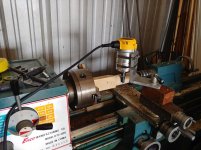I don't really see your set up as a hazard so much as later on it might bite you trying to fight vibration, and things that bounce or shift when making a last cut, etc. Not as rigid as it could be to get the same result.
Cut about 1/2 the horizontal leg off and get the angle back over the compound. No downside to running the compound (with the cross slide) closer to the work, everything gets more rigid.
You could probably cut the top leg down a bit too, depends if a riser is more rigid, or the router way up top on the angle.
Is the riser a rusty steel drop? Or a piece of wood? (I honestly can't tell)
If you have the face plate that should have come with the lathe, the angle can be mounted to it by the horizontal leg, with the vertical leg sticking out horizontal, centered. Outside face of vertical leg in/toward spindle center. It should be about 1/4 or 3/8" less than the router case radius from the center of rotation. With a heavy boring bar, you can now turn a radius on the face of the angle that matches the router. Does not even have to be all that deep. But when things settle and shift, the router will still maintain it's alignment against the angle; guided by that cove cut.
It is even possible to make the cove cut diagonally on a tablesaw, but if you didn't already know that, i certainly didn't mention it.

(Keep all your fingers, kind of convenient for cue making and many other activities.)
There's a lot of uses for a lathe compound, few of which include the compound being parallel with the cross slide. (waste of an axis).
For fussy work, parallel to the lathe axis at least gives a measuring system with the carriage locked.
Most machinists (when not threading) leave it at 30 deg. to the lathe centerline for this reason: dialing in .001 on the collar results in a tool infeed of 1/2 that. It doubles your resolution, which is convenient when working to .001 or less. Also, if the cross slide dials are not direct reading, the compound set at 30 deg becomes direct reading. If your cross slide dial is direct reading, you may or may not appreciate the added resolution.
(Non-direct reading - dial in .001, slide moves .001", means .002 off the diameter. Direct reading means dial in .001, and slide actually only moves .0005, taking 001" off the dia.)
smt
 Finally started my next quest. Just built out the router arm this past weekend and got to test it on some scrap poplar laying around. I am still pulling together some tooling which brings me to my question. When it comes to coring what is the minimum I can do? I purchased a 14.2mm x 430mm gun drill which is .006 larger than 9/16. Would this be sufficient for forearm/handle/butt coring?
Finally started my next quest. Just built out the router arm this past weekend and got to test it on some scrap poplar laying around. I am still pulling together some tooling which brings me to my question. When it comes to coring what is the minimum I can do? I purchased a 14.2mm x 430mm gun drill which is .006 larger than 9/16. Would this be sufficient for forearm/handle/butt coring?